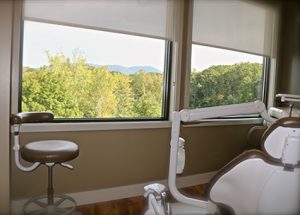Header logo
header top contact widget
Oral Sedation
Are Dentures Or Partials Causing Your Face To ‘Melt’?
Posted on Feb 12, 2020 by William J. Claiborne, DDS MS
Occasionally, I’ll unexpectedly walk by a mirror and notice an old man looking at me, only to realize “that’s ME!”
As we age, hopefully most people don’t “feel” their actual age, although the person in the mirror isn’t quite the image we want to have. Most of us “see” ourselves as looking ten or so years yo unger (and probably 10 or so pounds lighter!).
unger (and probably 10 or so pounds lighter!).
Aging gracefully is a positive part of our lives. At any age, as long as we look and feel like we’ve taken pretty good care of ourselves, each birthday should cause more smiles than not. However, for people who are long-time denture or partial wearers, the signs and challenges of aging are more obvious.
Wearing a full denture or a partial denture appears, visually, to replace missing teeth. While the gum based that supports these replacement teeth “plumps up” the face when they are in place, this fullness can be deceiving.
What is really taking place – that you can’t see – is the loss of bone mass, or resorption.
Resorption describes a melting away of bone. For the upper or lower jaw, the areas where natural tooth roots no longer exist experience this almost immediately after they are removed.
Resorption occurs when tooth roots are no longer providing stimulation and nourishment to the bones that support them. This causes the bone “ridge” that holds the denture or partial to flatten out.
Bone loss begins almost immediately after teeth are removed. The pressure on the ridge while wearing dentures or partials actually accelerates the rate of bone loss. For people who sleep in their dentures, this increases the process even more.
In addition to appearance changes, bone loss is the reason that dentures slip or rub. This is because the denture was conformed to the ridge when it was first made. As the ridge flattens, the denture no longer ‘hugs’ the surface it was designed for.
As resorption continues, changes in facial appearance are occurring as wel. The best way to detect bone loss is to remove your ‘appliance’ and look in the mirror. However, even with the denture in place, certain facial changes may be obvious.
Jowls form on the sides of face as facial muscles detach from the declining bone mass. Deep wrinkles form around the lips and the corners of the mouth turn down, even in a smile.
As resorption worsens, the mouth seems to collapse into the face. The chin becomes more pointed and the nose and chin move closer together. This appearance is referred to as a “granny look,” aging one’s appearance far beyond their actual years.
How do you avoid a ‘melting face’?
One of the many advantages of dental implants is their ability to halt bone loss. The implanted portion restores stimulation to the jaw bone and provides a natural biting and chewing stability.
As a periodontist, an area of this advanced dental specialty is the diagnosis and placement of dental implants. Because there are many different types of implant systems, having a specialist select and place the one best for you will enhance your overall outcome.
In our Asheville periodontal office, we also offer oral and IV sedation (twilight sleep). These are administered by a board certified Anesthesiologist. This is a medical doctor (MD) who ensures safety and comfort are priorities throughout your procedure.
With dental implants, you can improve your appearance and health. Learn more about the lifelong benefits of dental implants by visiting our web site or calling 828-274-9440.
The Value Of Dental Implants Goes On & On.
Posted on Jan 08, 2020 by William J. Claiborne, DDS MS
Many people have a list of favorite holiday movies. One that stand out for me is “Christmas Vacation,” where Clark Griswold attempts to create the perfect Christmas for a hoard of family members who have descended upon his home.
In the movie, Clark learns that, instead of his company’s annual Christmas bonus, he’s received a certificate for “Jelly of the Month” club. Cousin Eddie famously comments, “It’s the gift that keeps on giving.”
Laughs aside, this always reminds me of how much we spend, all year long, on things that really add very little to our lives. People invest in new cars, clothes, jewelry, and fancy electronics – many purchases based on ads indicating these items will bring us great pleasure.
Yet, year after year, Americans struggle to pay January credit card bills laden with holiday purchases. And, we begin a new year not as fulfilled as we thought. I’d like to make a suggestion: your smile!
Is there anything that would give you as much pleasure as a healthy, confident smile?
Life’s best moments are things like laughing with close friends, dining out in our favorite restaurant, close conversations with loved ones, and the bite of a red apple picked right off the tree.
As a Periodontist, I see how difficult life can be for patients with dentures and partial dentures. To witness the transformation of an individual who has replaced “slippery” dentures with dental implants has been a particular joy throughout my career.
Over the past three decades, there have been remarkable advancements in implant dentistry. It has easily become the preferred replacement for missing, natural teeth. Today, there are implant types that offer exceptional choices to fulfill nearly any need when it comes to replacing teeth with dependable stability and a natural look and feel.
While I share the excitement of our implant patients when they “see” their appealing, confident smiles after treatment completion, as a periodontist, I know it is the foundation beneath the gums that is the true benefit of dental implants.
Like natural teeth, implants are held by the upper or lower jaws. The jaw bones actually thrive on the presence of tooth roots for stimulation to keep the bone healthy. Without tooth roots, the bone goes through a process known as resorption. Resorption causes bones to lose height and width, almost like they are melting.
Dental implants are able to mimic the stimulation they need to prevent the process of resorption.
Bone loss contributes to a number of problems. Once resorption sets in, the teeth adjacent to the area of bone loss are affected. Bone loss that neighbors areas of resorption weakens tooth root stability. When a natural tooth is lost, statistics show the next to be lost will most likely be an adjacent tooth.
Bone loss can even be seen in some people. It causes the appearance of a collapsed mouth (referred to as a “granny look”) where the nose is unusually close to the chin. It is also the reason that dentures and partials begin to move or “slip.” This can cause uncomfortable rubbing on gum tissues.
When a denture is first made, it is shaped to fit the unique contours of your gum ridge (the gum-covered arch that once held your natural tooth roots). As bone loss continues, the once-secure fit loosens and cause sore spots on tender gum tissues while chewing. Denture pastes or adhesives can help, but eventually even relines are of little help.
For many, another appealing advantage of dental implants is that they are a lifelong investment. Dental implants, properly selected and placed, are designed to last a lifetime with proper maintenance.
Adults are also seeing dental implants as a wiser option than crown-&-bridge combinations. Unlike dental implants, crowns and bridges can require repairs or replacements over time. Too, crowning natural teeth for the sole purpose of supporting a bridge forever compromises the health of otherwise natural teeth.
Dental implants do not rely on adjacent teeth for support since they are anchored in the jaw bone. This restores the same, sturdy foundation as natural tooth roots. An added bonus is how the implanted portion recreates the presence of a tooth root, halting the process of resorption.
If you are missing natural teeth, consider the advanced skills of a periodontist to consult with on dental implants. For a private, no obligation consultation to discuss your specific goals or concerns, call 828-274-9440 for an appointment.
If fear of dentistry is an obstacle for you, we can also discuss our sedation options. Our office is known for providing respectful, gentle care and oral and IV sedation are available as needed, administered safely and to the highest standards. Feel free to mention your concerns during your consultation.
Afraid of the Dentist? Here’s How To Get Your Smile Back!
Posted on Oct 11, 2019 by William J. Claiborne, DDS MS
Have you ever suddenly seen a snake out of the corner of your eye?
Immediately, the brain kicks in a “fight or flight” response that causes us to react. Because we don’t know whether or not the snake is poisonous, the typical reaction is to quickly move away from danger.
Past trauma can also trigger reactions. Past experiences can sometimes cause people to react in ways they can’t control. For adults who have experienced a frightening or painful dental procedure, the fear it caused can become embedded (sometimes forever) in the subconscious.
Some things that cause us to flinch or freeze can occur from reasons we can’t even explain. Patients who are nervous or afraid when they first arrive often know what past episode triggered it. Some are unable to recall an unpleasant dental visit yet react to certain sights, smells or sounds.
Dental fear occurs in different people at different levels. It can activate reactions of more rapid heartbeat, sweating, heavier breathing, and muscle tension.
Here, at our Asheville periodontal office, most patients are relaxed from the moment they walk in and throughout treatment. Some are fine until they are seated in the treatment chair while others are nervous and uneasy the entire time.
Dental fear and anxiety are often the result of an unfortunate experience in a dentist’s office that made the person feel out of control and trapped. This tends to carry over so that perceived pain can be just as real as actual pain.
Experiencing uneasy feelings at dental visits is not uncommon. According to the Cleveland Clinic, between 9 – 15 percent of Americans say they avoid going to the dentist because of anxiety or fear. (https://my.clevelandclinic.org/health/diseases/11176-dental-phobia-in-adults)
They also cite the most common causes as:
- Fear of pain
- Fear of injection or that the injection won’t work
- Fear of anesthetic side effects
- Feelings of helplessness and loss of control
- Embarrassment and feeling encroachment of personal space
Periodontal (gum) disease is the result of an accumulation of oral bacteria. It is also the leading cause of adult tooth loss. As a Periodontist, I find that most individuals have developed gum disease because they were too afraid of having regular dental care. Many avoid going to the dentist for years, only ‘giving in’ when something becomes so painful they can no longer delay treatment.
At Biltmore Periodontics, patient comfort is a priority at every visit. And, it is obvious from the moment you walk in our door. Our reception area is designed to pamper patients from the moment they enter. Patients are treated to a selection of gourmet coffees, cable television and WiFi connection. Seating is comfortable and our front office staff is attentive to the needs of each guest.
New patients begin in a private consultation room so we can discuss treatment needs and concerns in a living room style setting. During this time, I’ll answer your questions and explain treatment options, including sedation.
We offer oral sedation as well as I.V. sedation (twilight sleep) for most procedures, if desired. Oral sedation is a pill that helps patients relax. It also has an amnesiac effect, leaving most with little or no memory of treatment afterward.
 I.V. sedation places the patient in a deeper sedative state, also erasing memory of the procedure. It is administered by a doctor of anesthesiology for optimal comfort and safety. With both, patients are monitored with advanced safety equipment throughout treatment.
I.V. sedation places the patient in a deeper sedative state, also erasing memory of the procedure. It is administered by a doctor of anesthesiology for optimal comfort and safety. With both, patients are monitored with advanced safety equipment throughout treatment.
Our surgical suite offers a large window with beautiful mountain views. This is very soothing and relaxing for patients as they are attended to by gentle, compassionate hands.
Our entire staff provide a unified team, each bringing a sincere level of compassion and commitment to excellent care. While the doctors involved in your care are top-notch, I am always happy to hear so many patients tell me how our staff helps them to feel at ease and pampered.
It doesn’t take long for patients to realize our goal is to provide skilled care delivered with comfort. The more they experience this, the more relaxed they become and develop a sense of trust.
When patients trust us, many no longer need to feel anxious and “white-knuckled” in a dental chair. And, they see their dental care as a positive part of their overall health, which makes them more involved with their oral health – and smiling confidently!
Like everyone, fearful patients desire a healthy, confident smile. Once the obstacle of fear is removed, their ability to achieve that is greatly heightened.
If you or someone you know has fear that has prevented needed or desired dental care, schedule a consultation appointment. Call 828-274-9440 to learn more.
Know The Unseen Risks Of Wearing Dentures
Posted on Sep 19, 2019 by William J. Claiborne, DDS MS
As an Asheville periodontist, my goal is to provide each patient with the very best so they can enjoy a healthy, confident smile. For patients who have lost one or more natural teeth, some come to me because they want to avoid ending up having to wear a full or part ial denture. For those who wear one and are unhappy with the feel and function, we are sought out as specialists in the diagnosis and placement of dental implants.
ial denture. For those who wear one and are unhappy with the feel and function, we are sought out as specialists in the diagnosis and placement of dental implants.
Denture wearers, especially those who have worn dentures for many years, can quickly become dissatisfied with the uncomfortable rubbing and difficulty eating foods they once enjoyed. Although their ‘appliance’ may have fit well when first made, changes in the fit, over time, are due to what is taking place below the gum tissues. These changes aren’t obvious, at first.
When first made, a denture is custom-designed to fit snugly to the unique contours of the gum ridge. This ‘ridge’ is the raised arch where natural teeth were once held. Over time, denture wearers begin to notice that the denture moves while chewing certain foods. This can rub sore spots on gums. As the denture loosens more, even using denture adhesives or pastes don’t help much.
Denture patients also learn that it can be painful for something as small as a sesame seed to become trapped between their denture and gums, piercing into tender gum tissues. Some people eventually switch to a diet of soft foods that dissolve easily to avoid rigorous chewing. Because of fear of embarrassing slips, others begin to decline social invitations when they are centered around food.
The problem for a denture wearer is what is happening underneath the gums. The looser fit is not because the denture has expanded – it’s the decline of the jaw bone. This occurs with the absence of tooth roots, which once provided nourishment and stimulation to the bone that supported them.
When natural tooth roots are removed, the jaw bone begins to shrink. This decline in bone mass also contributes to changes in facial appearance, such as deep wrinkling around the mouth and the formation of jowls.
The process of bone loss continues as the gum ridge your denture was contoured to flattens. Relines may temporarily adjust the denture to accommodate some of the change. However, as the jaw bone continues to decline, the denture continues to be difficult to keep in place.
The denture itself merely adds to the problem of bone loss. The pressure of wearing a denture actually accelerates the rate of bone loss. Since a number of denture wearers also sleep in their dentures, the 24/7 pressure speeds this rate even more.
Long-time denture wearers often complain that they are not able to chew, with some admitting they have to even remove their denture to eat. Fear of embarrassment is another common complaint. Speaking, laughing and even sneezing in the presence of others can create embarrassing moments that leave lasting impressions.
The solution to these problems – dental implants. Not only do implants restore the ability to bite and chew comfortably, they halt bone loss that is associated with dentures. Because they are held by the jaw bone, just as natural tooth roots once were, implants recreate the stimulation needed by the jaw bone to maintain its mass.
Does your denture bring to mind words like rocky, wobbly and slippery? If so, the problem will only worsen over time. When people choose dental implants to replace an ill-fitting denture, they can smile, laugh and chew with confidence.
Eating a healthy diet, socializing with friends and family, and feeling confident are essential to a healthy, happy life. Call our friendly Asheville periodontal dental office: 828-254-9440 to schedule an initial appointment. (A referral is not required). During this time, I’ll explain the type of implants that may be best for your needs as well as comfort options, including oral and IV sedation (“twilight sleep”). We are also happy to discuss estimated costs and payment options.
Recent Posts
Categories
Archives
- September 2024
- August 2024
- July 2024
- June 2024
- May 2024
- April 2024
- March 2024
- February 2024
- January 2024
- December 2023
- November 2023
- October 2023
- September 2023
- August 2023
- July 2023
- June 2023
- May 2023
- April 2023
- March 2023
- February 2023
- January 2023
- December 2022
- November 2022
- October 2022
- September 2022
- August 2022
- July 2022
- June 2022
- May 2022
- April 2022
- March 2022
- February 2022
- January 2022
- December 2021
- November 2021
- October 2021
- September 2021
- August 2021
- July 2021
- June 2021
- May 2021
- April 2021
- March 2021
- February 2021
- January 2021
- December 2020
- November 2020
- October 2020
- September 2020
- August 2020
- July 2020
- June 2020
- May 2020
- April 2020
- March 2020
- February 2020
- January 2020
- December 2019
- November 2019
- October 2019
- September 2019
- August 2019
- July 2019
- June 2019
- May 2019
- April 2019
- March 2019
- February 2019
- January 2019
- December 2018
- November 2018
- October 2018
- September 2018
- August 2018
- July 2018
- June 2018
- May 2018
- April 2018
- March 2018
- February 2018
- January 2018
- December 2017
- November 2017
- October 2017
- September 2017
- August 2017
- July 2017
- June 2017
- May 2017
- April 2017
- March 2017
- February 2017
- January 2017
- December 2016
- November 2016
- October 2016
- September 2016
- August 2016
- July 2016
- June 2016
- May 2016
- April 2016
- March 2016
- February 2016
- January 2016
- December 2015
- November 2015
- October 2015
- September 2015
- August 2015
- July 2015
- June 2015
- May 2015
- April 2015
- March 2015
- February 2015
- January 2015
- December 2014
- November 2014
- October 2014
- September 2014
- August 2014
- July 2014
- June 2014
- May 2014
- April 2014
- March 2014
- February 2014
- January 2014
- December 2013
- November 2013
- October 2013
- September 2013
- August 2013
- July 2013
- June 2013
- May 2013
- April 2013
- March 2013
- February 2013
- January 2013
- December 2012
- November 2012
- October 2012
- September 2012
- August 2012
- July 2012
- June 2012


